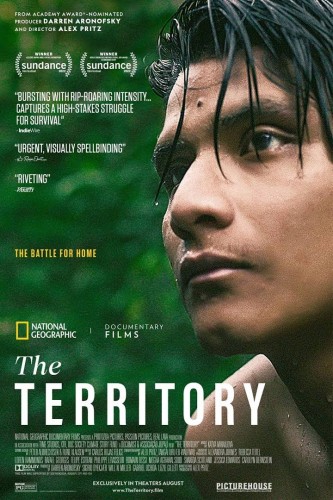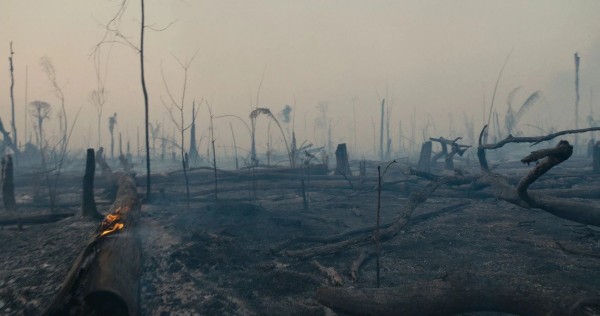ALEX PRITZ: THE TERRITORY (2022) - DocLands Festival
BATITÉ URU-EU-WAU-WAU IN THE TERRITORY
The war on nature and native populations in the Amazon and how they fight back
The focus of this beautifully made new documentary, The Territory, is the Uru-eu-wau-wau people, indigenous natives of the Amazonian rainforest region who once numbered in the thousands and now are reduced to about 180. They live in an island of trees surrounded by invaders' farms encouraged by the right wing Brazilian leader Jair Bolsonaro elected in 2018, the starting point of the three-year period covered by this film. The "territory" is a 7,000-square-mile region in the Brazilian state of Rondônia, sovereign land of the Uru-eu-wau-wau and other Indigenous groups. It is being invaded and destroyed by white settlers. The white people say the indigenous people ask for too much land, says an Uru-eu-wau-wau spokesperson, but they need it to breathe. And the rainforest, we know, is needed for the planet to breathe, for humanity to breathe.
The planet has become overpopulated; feeding it endangers the environment. The food doesn't need to be meat, but that most damaging industry is most profitable. The cultivation of livestock ravages the earth and increases global warming. Consuming meat en masse will ultimately become unsustainable.
The planetary tipping point is the Amazon rainforest, the "lungs of the planet" which are being excised to provide lumber and cleared land for livestock farming. This is the larger subject of The Territory - a film stunning in more ways than one, because it is both beautiful and horrifying. It is the work of brilliant cinematographers - Alex Pritz himself and indigenous collaborators supplied with cameras - and with the rich sound design of Peter Albrechtsen. The lenses are neutral. The felling of great old grown trees is awesome, the drilling and crushing of wood. We admire equally the buzz of insects and birds and of saws; we see the flurry of butterflies and of wood chips flying and enjoy the sizzle of settlers' big pieces of barbecued meat.
It's like the white people invading North America, killing Native Americans and driving them off their land. But there are too many people now and not enough land. And now everyone knows the word "indigenous" and cannot claim these gentle native people to be "savages." The planet is running out of land, and the rainforest is more crucial than the American West ever was even when it was thought a mine of gold. What is happening here made me think of how the Zionists took over Palestinian lands, and Sheri Linden in her Hollywood Reporter review of The Territory has the same idea. She points out this film asks questions about how often "the pioneer spirit" has "gone hand-in-hand with genocide and the destruction of tribal lands in the Americas." Obviously the Uru-eu-wau-wau are threatened with extinction. But this is an extinction that threatens us all.
The focus is on a few of the Uru-eu-wau-wau we meet and learn the names of using drones who surveil and warn of invading settlers who seize their territory and settle on it and denude it and who record these incursions to report to the government. We meet numerous Uru-eu-wau-wau including Bitaté, age 18, chosen by the elders to be groomed as their new leader. He's aware of his great responsibility, of the rainforest's being crucial to the whole planet. Important is the environmental activist Neidinha Bandeira, who works tirelessly with the indigenous people to protect their land. She is not just a mentor to Bitaté but a "second mother." Bitaté also looks up to Ari, who leads the Uru-eu-wau-wau surveillance team, working with Neidinha. (Later Ari is assassinated, and Neidinha puts up a billboard demanding to know who did it.)
Soon we see the logic of Bitaté as leader: he is young, and so he's electronics and media savvy. He shows his comrades how to use drones and wireless communications and cameras inter-connectedly to provide clear legal evidence of incursions. They are a team, they wear matching T shirts and shorts and they are armed - both with electronics and with bows and arrows.
In the other camp we meet Sérgio, founder of the settlers' Association Rio Bonito, founded to legitimize their activities, who look on themselves as Wild West style pioneers "living the dream" of "owning some land and making a living from it." Sérgio, who is 49, has worked other people's land all his life, seeks to map and register the settlements - though there are settlers, represented by Martins, who haven't time for that and are ready to serve jail terms in the course of gaining possession of land. We can understand these men's dreams; but we also understand that big farmers may very well be waiting in the wings and have nothing idealistic or admirable about them.
This is the present day, and now it is August 2020, and the COVID pandemic, brought to the region of course by the settlers, threatens to wipe out the indigenous people. In an exciting sequence of filming by the team of Bitaté, we see the Uru-eu-wau-wau become more active, sneaking up on and arresting invaders, burning their settlements - actions that gain national media attention so hat politicians drop the Association and Sérgio disbands Rio Bonito because it's anathema now. The tide is still against the Uru-eu-wau-wau, but the film ends on a positive note. And a stunning impression of its supple score by Katya Mihailova, rich sound design, and incredible cinematography and editing. A first rate job about issues crucial to the planet.
The Territory, 83 mins., debuted at Sundance Jan. 22, 2022 (two documentary awards there), and showed in eight other festivals including Copenhagen, True-False, and It's All True (Sao Paulo). Five awards and seven nominations. Now screening at DocLands, Mill Valley, CA, May 6, 2022. : 88%. A National Geographic film. Metacritic rating: 84%.





 Reply With Quote
Reply With Quote


Bookmarks